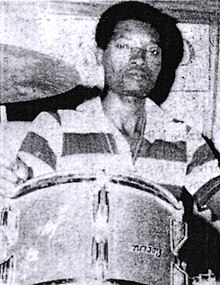
Cavacha is a Congolese rumba style drum beat, created by Meridjo Belobi, long-time drummer of Zaïko Langa Langa.
History

Cavacha has two conflicting origin stories. The first story is recounted by the lead members of Zaïko Langa Langa, the band credited with popularizing the rhythm. They claim that during a 1973 tour to Pointe-Noire from Brazzaville, the rhythm was inspired by the churning sound of a run-down railroad engine heard during an overnight train journey. Band members were singing and dancing all over the trip. Singer Evoloko Jocker then asked the band's drummer, Meridjo Belobi, to imitate the sound. After returning to Kinshasa, they decided to adopt this rhythmic sound as one of their new musical signatures.
The second story comes from Meridjo Belobi, Zaïko Langa Langa's drummer and the acknowledged creator of the cavacha rhythm. According to Belobi, he first heard the rhythm being played on a big drum with one stick while enjoying a beer and listening to an urban traditional musical ensemble in Kinshasa. He adapted it to Zaïko's music by adding ghosted 16th notes, and thus cavacha was born.
Regardless of the specific origin, cavacha is considered the mother rhythm of contemporary Congolese dance music. Meridjo Belobi, who played a pivotal role in its development, earned the nickname Masini Ya Kauka (Lingala for "the engine of Kauka"). Cavacha has since become an indispensable element in creating a good sebene—the instrumental and highly rhythmic section of Congolese rumba typically played towards the end of a song, emphasizing the lead and rhythm guitars for dancing.
Cavacha was also the name of a dance created by Evoloko Jocker and launched by Zaïko Langa Langa.
Characteristics and variations
Cavacha's primary phrase is traditionally played on the snare drum, though it can also be executed on the hi-hat. The bass drum underscores the rhythm by striking on every beat, lending a robust, driving feel. The rhythm mainly utilizes the snare and bass drums, with variations manifesting through occasional fills or scattered crashes and hits. These variations, while numerous, consistently refer back to the original cavacha pattern. Songs devoid of a sebene section are the only exceptions that do not employ this rhythm.
Examples
Zaïko Langa Langa, with Meridjo Belobi on drums, has numerous songs that feature the cavacha rhythm. Notable examples include:
- "Mbeya Mbeya" (1973): one of the early recordings of the cavacha rhythm
- "Kwiti Kwiti" (1979)
- "Où es-tu Lomas ?" (1996)
Beyond Congolese rumba, the cavacha rhythm has influenced and been incorporated into various other musical genres, such as Coupé-décalé (in songs like "Djessimidjeka" by DJ Arafat), Zouk (as heard in "Mwen Malad Aw" by Kassav') and various Latin American styles.
References
- ^ White, Bob W. (2008-06-27). Rumba Rules: The Politics of Dance Music in Mobutu's Zaire. Duke University Press. ISBN 978-0-8223-4112-3.
- "Curtain falls on Zaiko Langa Langa ex-drummer Meridjo Belobi". Nation. 2020-08-29. Retrieved 2024-05-15.
- "Chooka-chooka cavacha: here comes the Congolese rumba". www.bruzz.be. Retrieved 2024-05-15.
- Messager (2011-03-03). "Belobi "Meridjo", créateur du Tempo "Machine ya Kauka"". MBOKAMOSIKA (in French). Retrieved 2024-05-15.
- A.M (2023-08-27). "Jean-Marie Belobie N'gekerme, l'un des plus grands batteurs du Congo, s'est éteint le 27 août 2020, à Liège, en Belgique". La Gazette du Continent (in French). Retrieved 2024-05-15.